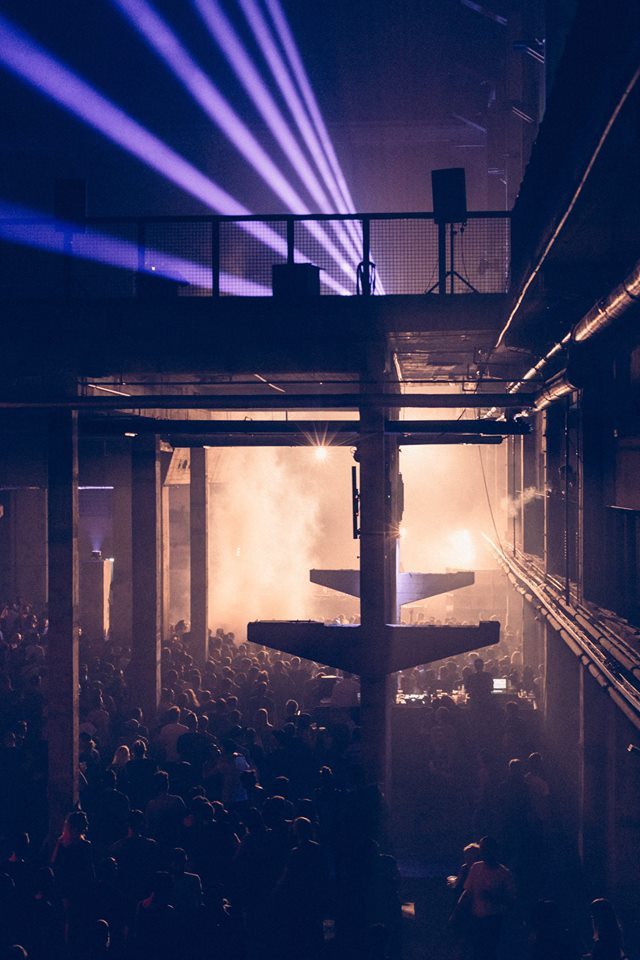First night of the program, I launched into
Tresor’s anniversary weekend challenge trying to reminisce less about the club’s legendary status and worry more about the overly packed line up, which had some personal heroes overlapping. I made my way into the Kraftwerk Halle to some beautiful, balearic krautrock with an industrial edge played by Berlin icon
Gudrun Gut - the crowd was starting to aggregate - original 90s ravers and young nostalgic revivalists, the queue was merging killer looks and random destroyed textiles, moving slow enough to leave time for a mental rewind of all the expectations a Tresor themed weekend would compile - was it going to play along its techno legend avatar, which made it the subject of crazy youtube archaeology and anecdotes - and how much would the tourist-friendly policy contribute to the birth of a new rave dynamic?
At a first glance, whatever was going on sartorially didn’t look too far from the original 90s footage which was looping on a wall of TV screens, documenting Tresor’s earlier years. This video installation was a potential sneak peak into what a techno museum would boast on visual level, and even though at first I found those moving image memorabilia a bit silly, I had to admit by the end of the night that both the actions and the people on display, apart from becoming an involuntary exhibit, were having hell of a good time and that’s exactly what happened in the real and present moment, by the end of the opening night.
Being the first chapter of an extended feast which looked both disarming and threatening at a first timetable glance, Day 1 had enough potential to turn into an unpredicted monster rave, but enough rewarding acts on the first half of the bill, in order to not cause too much disappointed among those having to leave the program pretty early. And well, you guessed it, most of them didn’t. By 7 AM club
OHM was packed, sweating out to
DJ Stingray spinning some Drexciyan cuts while, crowd dynamic considered, a beautiful chaos was going on in the big room (ground floor of Kraftwerk Halle) - to live unpredictable techno by
Sleeparchive and
DJ Pete presenting
TR - 101, respectively
Mike Dehnert later on. Speak of
Drexciya, one could relish to the vibes of Gerald Donald’s
Arpanet performing live, earlier in the program.
Surprisingly, the supposed-to-be-mild opener turned to be one of the most intense festival days, be it due to the forbidden temptation of calling in sick the next day at work, or just because the first chapter of a four day ride is that blank slate containing an infinity possibilities, most of which would have to exhaust as soon as possible, crumbling to the pressure of a week’s accumulation of calories and energetic surplus.
Highlights:
Reka’s wave driven opening set got the room full and the party started in Ohm very early – by that time
Gudrun Gut was spinning some chill motoric machine music and the many people gathered there to hear it were still too few to fill in a whole floor of Kraftwerk Halle, and thus, they were trying to shake off that first-day-of-school kind of festive energy that comes with any opening of something that’s about to happen much.
One of the most anticipated moments of the festival brought
Juan Atkins and
Moritz von Oswald as
Borderland, playing a chilling live set which started out with suspense and feeling, weaving ambient sequences into a laid back old school techno number, as summery and wet-sounded as Borderland can get. I find it had a lot of soul-feeding factor to it, besides technique, but the “serious music” vibe reminded me more of a concert of classical music than of an environment open to proper trashing.
The crowd was agitating to the beat regardless, while I came to terms with the idea that once influential and established, a music form will change radically even by remaining the same in itself, and timelessness is not a warrant of transcending time but just the other way around. I found it baffling that I would’ve rather sat down and watched the act eyes closed, as a performance, and envied for a second literally everyone who came there to rave physically to any music playing.
Right after, the night just unfolded manically as commuting between the live analog techno going on in Kraftwerk and the extended DJ Stingray jam, who was preceded by
Helena Hauff showcasing her flawless flair to keep a dance-floor bouncing. It was more than anything an inspired succession.
Here’s a video glimpse showing
DJ Stingray playing back to back with
Juan Atkins - few people saw this happen, but it was probably the most talked about insta-evidence by the end of the night - as recorded by Vienna label
Trust.
By the time
Dennis Zegarnik started his closing set in Ohm the Sun was up - and the club was pitch dark, bathed in red lights and not yet empty. Hearing Zegarnik spin was a refreshing moment - after a night full of old school techno, house and analogue electronic, I thoroughly enjoyed some deep esoteric bass ambient cuts, the kind that make you spell Ohm’s letters as actually Aum.



